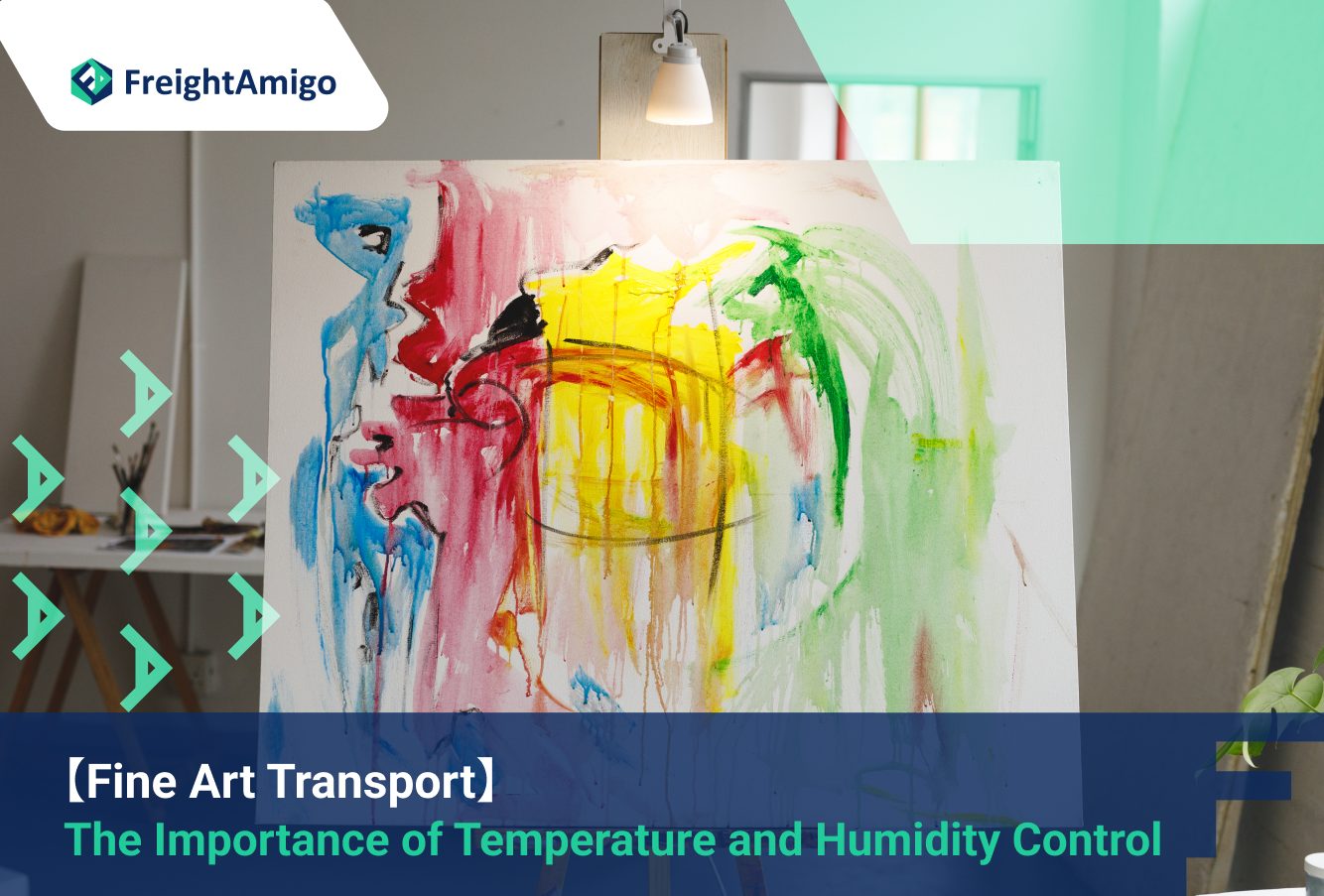Author Name: Tiffany Lee – Marketing Analyst at FreightAmigo
Fine art transport is a delicate and intricate process that requires careful consideration of various factors to ensure the safe and secure transportation of valuable artworks. One of the most critical aspects of fine art transport is temperature and humidity control. Proper temperature and humidity levels are crucial in preserving the integrity and longevity of artworks, preventing damage caused by environmental fluctuations. In this article, we will explore the significance of temperature and humidity control in fine art transport and discuss the measures taken to protect artworks during transportation.
Want To Compare The Best Express, Air Freight, Sea Freight, Rail Freight & Trucking Rates So As To Have Better Control On Cost?
Understanding the Impact of Temperature and Humidity on Artworks
Artworks, whether they are paintings, sculptures, or other mediums, are highly sensitive to changes in temperature and humidity. These environmental factors can have detrimental effects on the materials used in artworks, leading to warping, cracking, fading, mold growth, and other forms of damage. To protect artworks during transport, it is essential to maintain stable temperature and humidity levels.
Temperature Effects on Artworks
Extreme temperatures can cause significant damage to artworks. When exposed to high temperatures, certain materials, such as paint and adhesives, may melt or become soft, leading to irreversible changes in the artwork’s appearance. On the other hand, extremely low temperatures can cause materials to become brittle and fragile, increasing the risk of breakage during transportation.
Humidity Effects on Artworks
Humidity, which refers to the amount of moisture in the air, can also have a profound impact on artworks. High humidity levels can result in the absorption of moisture by the artwork’s materials, leading to swelling, warping, and mold growth. Conversely, low humidity levels can cause materials to dry out, shrink, and become brittle, increasing the risk of cracking and deterioration.
The Role of Climate-Controlled Transportation
To mitigate the risks associated with temperature and humidity fluctuations during transportation, the use of climate-controlled vehicles and storage facilities is crucial. Climate-controlled transportation involves maintaining a stable and controlled environment inside the vehicle to ensure the optimal conditions for the artworks.
Climate-Controlled Vehicles
Climate-controlled vehicles are specially designed to regulate temperature and humidity levels, providing a controlled environment for the artworks during transportation. These vehicles are equipped with advanced HVAC systems, insulation, and monitoring devices to maintain the desired conditions. Temperature and humidity levels are monitored continuously to ensure they remain within the recommended range.
Climate-Controlled Storage Facilities
In addition to climate-controlled vehicles, artworks may also require storage in climate-controlled facilities during transit or between locations. These storage facilities are equipped with advanced climate control systems to maintain stable temperature and humidity levels. Artworks are stored in specially designed crates or containers that provide additional insulation and protection.
Best Practices for Temperature and Humidity Control in Fine Art Transport
When transporting fine art, it is essential to follow best practices to ensure proper temperature and humidity control. Here are some key considerations:
Pre-Transport Preparation
Before transporting artworks, it is crucial to conduct a thorough assessment of the specific temperature and humidity requirements for each piece. Different types of artworks may have varying sensitivity to temperature and humidity. Consulting with art conservation experts can provide valuable insights into the specific needs of each artwork.
Monitoring and Regulation
Throughout the transportation process, temperature and humidity levels should be continuously monitored and regulated. Advanced monitoring systems can provide real-time data on the conditions inside the vehicle or storage facility, allowing for immediate adjustments if necessary. Automated regulation systems can maintain the desired temperature and humidity levels, minimizing the risk of exposure to damaging environmental conditions.
Protective Packaging
Proper packaging is essential in protecting artworks during transportation. Artworks should be securely packaged in materials that provide insulation and protection from temperature and humidity fluctuations. Using specialized crates, foam padding, and moisture-absorbing materials can help create a stable microclimate within the packaging, minimizing the impact of external environmental conditions.
Secure Transportation
Transporting fine art requires careful handling and secure transportation methods. Artworks should be loaded and secured in climate-controlled vehicles, minimizing the risk of exposure to extreme temperatures and humidity. Drivers and handlers should be trained in the proper handling and care of artworks to prevent any accidental damage during transit.
Insurance Coverage
While temperature and humidity control measures significantly reduce the risk of damage during transportation, it is still essential to have comprehensive insurance coverage for fine art. Art insurance policies should cover potential damage caused by temperature and humidity fluctuations, ensuring financial protection in the event of any unforeseen incidents.
Advancements in Fine Art Transport Technology
Advancements in technology have revolutionized the field of fine art transport, offering innovative solutions to enhance temperature and humidity control. Here are some notable advancements:
Smart Monitoring Systems
Smart monitoring systems utilize sensors and data analytics to provide real-time insights into the conditions within the transportation vehicle or storage facility. These systems can detect any deviations from the desired temperature and humidity levels, triggering immediate alerts and allowing for prompt corrective actions.
Climate-Controlled Packaging Solutions
Developments in packaging materials have led to the creation of climate-controlled packaging solutions. These solutions incorporate advanced insulation and moisture-regulating technologies to create a stable microclimate within the packaging. They can adapt to changing environmental conditions, providing added protection during transportation.
Remote Temperature and Humidity Control
Remote temperature and humidity control systems allow for the adjustment of conditions within the transportation vehicle or storage facility from a remote location. This technology enables real-time monitoring and regulation, even when physical access to the artwork is not possible. It provides an extra layer of control and convenience for fine art transport.
Conclusion
Temperature and humidity control play a vital role in ensuring the safe and secure transport of fine art. By maintaining stable environmental conditions, the risk of damage caused by temperature and humidity fluctuations can be significantly reduced. Utilizing climate-controlled vehicles, storage facilities, and advanced technology, the art transport industry continues to innovate and enhance the protection of valuable artworks. When transporting fine art, it is essential to prioritize temperature and humidity control to preserve the integrity and longevity of these precious cultural treasures.
There Are Different Options For Cargo Transportation. If You Want To Choose The Most Convenient And Suitable Solution, It Is Best To Have The Full Support Of Logistics Experts! If You Are Planning To Ship Goods Overseas, Please Go To The FreightAmigo Page For Inquiries.
===
Read More:
【Cosmetic Product Recycling】 A Guide to Sustainable Reverse Logistics
【Rise of Green Supply Chain】 Pioneering Sustainable Practices in Logistics
【ESG in Logistics】 How ESG Practices Drive Social Responsibility in Logistics
===
If you have any inquiries on logistics/supply chain, feel free to contact FreightAmigo now:
Chat with us online OR
Phone : +852 28121686
WhatsApp: +852 27467829









































